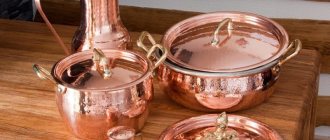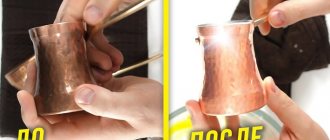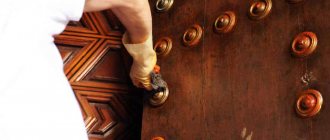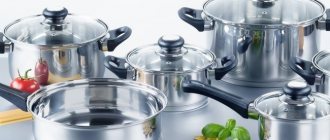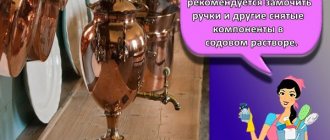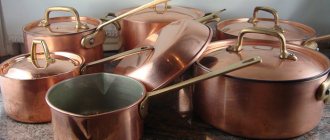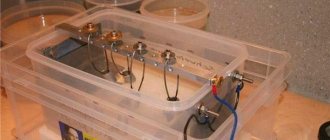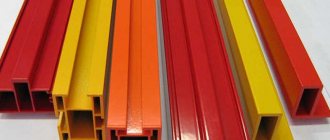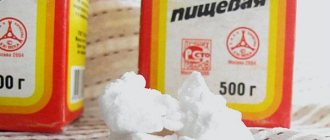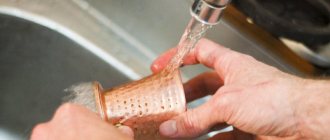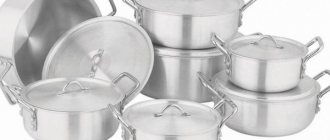Copper is a metal that becomes cloudy over time and loses its natural luster. This fact is associated with constant contact of the metal with a humid air atmosphere. The destruction of copper is a natural process, so it makes sense to use natural remedies to combat blackness and metal oxides.
There are many commercial products that are designed to clean copper from oxides, but these products contain chemicals that are harmful to human health. Luckily, there are a number of home remedies that can be used to clean copper products and are even recommended instead of commercial products.
Metal oxidation
Copper (lat. Cuprum) is a chemical element , which in D.I. Mendeleev’s periodic table is designated by the symbol “Cu” and has serial number 29. It is a transition metal with a characteristic luster of a reddish hue. In most chemical compounds, copper exhibits the +2 oxidation state, but can sometimes be in the +1 oxidation state.
When exposed to open air, the color of the metal changes to red-violet, which is associated with the formation of Cu2O oxide (copper oxide I) on its surface, which then turns into CuO oxide (copper oxide II), which has a blackish tint. In turn, copper ions Cu2+ give it a bluish tint.
Copper objects placed for a long time in a humid atmosphere are covered with a dense hydroxyl film, which has a green color . Copper hydroxide is poisonous. Also, greenish-blue films of copper acetate can form on the surface, which are obtained as a result of the interaction of the metal with acetic acid, have a bitter taste and are poisonous. When using copper cookware for cooking, appropriate precautions must be taken to avoid poisoning due to the presence of oxides and hydroxides on the surface of the copper.
Plaque on a copper product
To determine whether the product chosen for cleaning is copper or consists of another metal, you can use a magnet. If the magnet is strongly attracted to the product and sticks to it, then you are not dealing with copper metal. If the magnet, when touched, is not attracted to the product and simply falls, then the metal in question is copper.
Having determined the material from which the object is made, it is necessary to find out whether there is a coating of oxides on top of it or whether it is some kind of varnish coating. To do this, you need to prepare a mixture of vinegar and sodium carbonate (baking soda), and drop a little of this mixture onto the darkened area of the product. If this area begins to quickly lighten and acquire a characteristic copper sheen, then the product is not varnished, since it is being cleaned in an aggressive environment. Products that are coated with a protective varnish coating can be cleaned and washed with warm water and soap.
Cleaning Rules
Any impact - chemical, mechanical, electrochemical - changes the state of the artifact, sometimes causing irreversible consequences.
Cleansing is a painstaking task
Therefore, before you start cleaning old coins, you should familiarize yourself with the rules:
- First, it is determined whether the item needs cleaning. It is better to immediately put ancient specimens whose metal core is damaged into plastic capsules or an album.
- Work begins when stains and plaque clearly appear on the surface; dirt obscures the image and threatens the fortune of the ruble.
- When choosing a means and processing methods, they look at the metal from which the money is minted.
- You should not try to scrub the surface until it shines: not every banknote can withstand such intense load, and shiny change often looks like a tasteless fake.
- Do not use a needle or awl to roughly pick off dirt in hard-to-reach areas of the field.
- Money should not be cleaned with abrasive powders or aggressive solutions (hydrochloric or nitric acid).
If a novice numismatist does not understand cleaning techniques, it is worth listening to the wise advice of experienced collectors.
Rusty growths are removed from valuable samples without touching the metal
Home Cleaning Methods
Natural remedies for removing black and green oxides from copper items and utensils involve using various combinations of the following ingredients: white vinegar, baking soda (sodium carbonate), flour, salt, lemon and ketchup. Instructions for use:
- Vinegar and salt. Wipe the metal object with a clean rag using the following mixture: one tablespoon salt and one cup white vinegar. Another way to clean copper from oxides is as follows: pour three glasses of water into a vessel and dissolve one tablespoon of salt in it, add one cup of white vinegar. Place the copper object that needs to be cleaned into the vessel and bring the contents of the vessel to a boil. After a few minutes of boiling, the coating should disappear. When the item becomes clean and acquires a characteristic shine, you need to wash it under running warm water and soap and wipe with a dry cloth. This cleaning method can be used not only for copper products that do not have a protective coating, but also for items that do have it.
- Ketchup. Apply a little ketchup to the copper item, leave the ketchup on the surface of the item for a few minutes, then wipe it thoroughly with a clean cloth. Wash the item with water and it will begin to shine again.
- Lemon and salt. To clean copper at home, in particular, non-fragile objects made from it, for example: pots, pans, coins, Turks and other products, you need to cut a lemon in half, apply salt to the cut of the fruit and wipe the copper object with it. You can also make a paste of lemon juice and equal parts salt and baking soda or flour. Wipe the item with the resulting paste, then wash it with warm water.
- Baking soda and lemon. Dissolve baking soda (sodium carbonate) in lemon juice and polish the oxidized copper object with the resulting solution using a clean piece of cloth.
- Baking soda. There are different ways to clean copper from blackness, for example, you can use regular baking soda. To do this, a tablespoon of this substance must be dissolved in one liter of water. Immerse the oxidized copper product in this solution and boil it for 25-30 minutes, then wash it with water and wipe dry. This method allows you not only to remove the green coating from the product and give it a natural shine, but also to get rid of the protective varnish coating, if any, on the product.
- Salt, flour and vinegar. An effective way to clean copper from oxidation products is to use a mixture of one spoon of salt, one spoon of flour and a small amount of white vinegar. After thoroughly mixing the ingredients, a thick paste is obtained, which should be applied to the dirty copper item and, using a dry piece of cotton cloth, wipe the item with small circular movements. This polishing can make the surface of an object mirror-like. After completing this procedure, you need to soak a cloth in a solution of white vinegar and water and wipe the item to remove any remaining paste from it. This cleaning method can also be used for products that have a varnish protective layer.
How to clean copper coins yourself
Source: Unsplash (@kdghantous)
If you have copper coins in your hands, then congratulations, you are the owner of antique value. You need to treat such a treasure with care, because you can accidentally remove important elements. There are several ways to clean carefully. You need to select them depending on what kind of plaque has formed on the surface of the coin.
- If the coating is yellowish, it means the coin contains more lead than copper. You need to clean off such deposits with 9% vinegar. Add it to a small container of water and put the coins in it. When the dirt is gone, the mixture must be carefully drained and the coins rinsed in warm water. Important! Until they are washed, you cannot handle them with unprotected hands!
- Green plaque can be better cleaned off with 10% citric acid diluted in a glass of water in a ratio of 1:10. Place coins in the solution and watch the reaction. As soon as the liquid turns green, remove the money. The final steps are washing and light polishing.
- The reddish oxide will come off if you dip the coin in a solution of ammonia or ammonium carbonate. You need to keep coins in this solution for several hours. Otherwise it will not be cleansed.
- Black deposits are removed by ammonia. In this case, it will also take several hours of soaking to see the result.
Regardless of the method you choose, do not forget about safety. Use gloves and a respirator. Important! Copper coins must not be cleaned with abrasives, potent drugs, concentrated acids and alkalis. Do not try to remove dirt by exposing it to high temperatures. This may cause the product to melt or lose its strength.
Use of chemicals
These copper cleaners are quite effective, but require extra caution. These include the use of sulfuric acid and the use of an aluminum plate in an electrolyte solution:
- Sulfuric acid. This substance very effectively removes oxides from copper metal, but before using it you need to make sure that the product consists only of copper, since if it contains other metals, then this acid can harm their appearance. Before using sulfuric acid, be sure to wear rubber gloves. You need to dilute the acid with water in equal proportions and place the copper product in the solution. As soon as the solution begins to bubble, remove the item and wipe it thoroughly. Leave the item to dry in the open air and the item will regain its original shine.
- Aluminum plate and salt. This method is based on the difference in electrode potentials of different metals. You need to take an aluminum plate, place it in a vessel with hot water, add a significant amount of salt so that the solution becomes supersaturated, that is, there is a precipitate of salt in it. Then place the copper product in the vessel so that it touches the aluminum plate. Wait a few minutes. As a result of the processes occurring in the electrolyte solution, the copper will look dirty, but stains on the copper resulting from the electrochemical reaction can easily be wiped off with a piece of cloth, so you need to remove the product from the solution and wipe it thoroughly with a dry cloth. And then it began to shine again.
How to tidy up a samovar?
A classic copper samovar can look very elegant and attractive. But only on condition that it is completely clean. Meanwhile, a dark film inevitably forms on the copper surface; it is created by contact with oxygen. A faulty device, which is only suitable for decorative purposes, needs to be filled with boiling water. If the samovar can still work, pour cold water into it and bring to a boil.
In the arsenal of a modern housewife, there are many different ways to maintain copper products in an attractive condition. The following methods are considered the most effective and common:
- Take a metal container that will hold the copper item. Fill it with water, add a little of any detergent or cleaning product. Using a soft cloth or sponge, remove light dirt from the metal surface. Then immerse the product in clean water to rinse off any remaining detergent.
- Freshly squeezed lemon juice works well even on old stains. Cut the lemon in half, rub it on the copper item, leave for a few minutes, and then rinse under running water.
- Tomato paste or ketchup are also good options for cleaning copper at home
. To carry out this procedure, squeeze the required amount of ketchup or paste into a container and lower the product into it. The copper item should be left in this product for 10 minutes and rinsed with warm water. After this treatment, the metal will look like new. - If your favorite copper piece has dark stains, try removing them with a vinegar solution. Fill a saucepan with water, dilute vinegar and salt in it. For 1 liter of water you will need 3 tbsp. l. vinegar and the same amount of salt. Dip the dish you are going to clean into the prepared solution, put the pan on the fire and bring the water to a boil, boil for 10 minutes and rinse with warm water.
- Pastes based on chalk and ammonia also cope well with dirt. To prepare this cleaning product, you need to prepare a 25% ammonia solution, ground chalk and water. Mix these three components in a ratio of 5: 2: 10. Treat contaminated copper items with the prepared paste and leave them for 10-15 minutes. Then thoroughly scrub the entire surface of the metal with a brush with medium-hard bristles. Rinse the product under running water and wipe dry with a soft cloth.
Cleaning copper cookware
To safely clean products, all these methods can be used only after a preliminary test of the metal’s reaction to the cleaning agent. Testing is carried out in a small area; if no changes have occurred, the entire product can be cleaned.
Often plaques of various origins form on copper utensils. There are several options for cleaning copper at home
to remove any plaque that has formed. They are presented in the table below.
| Plaque color | Product used | Cleaning method |
| Yellow color (formed when copper comes into contact with lead) | Acetic acid 9% | Place the product completely in acetic acid, after 15 minutes rinse with warm running water and wipe dry with a soft cloth. |
| Red color | 5% ammonia solution | The item is placed in the solution for 10 minutes, after which it is rinsed with water. |
| Black plaque | Ammonia | Moisten a soft cloth with ammonia and treat the entire surface of the metal. After cleaning the metal, wipe it with a clean cloth. |
| White plaque | Sulfamic acid | Using a sponge, carefully apply sulfamic acid to the entire surface of the product, and after 10 minutes, rinse it off with water. Be sure to use rubber gloves when handling this harsh chemical. |
| Green plaque | Oxalic acid, ethyl alcohol, turpentine Citric acid | All components must be taken in equal proportions, mixed and carefully treat the metal surface with a sponge. At the end of the procedure, rinse the product under water. Bright green plaque can be removed with citric acid. It must be diluted with water 1:2, treated with product, and washed off after 10 minutes. |
Useful tips and tricks
It is worth adhering to the following recommendations to maintain the shine of copper products for a long time:
- To preserve the natural copper shine of objects for a long time, you can use a protective varnish coating. For example, cheap copper jewelry can be coated with clear nail polish. This method allows you to isolate the product from contact with the air atmosphere and human skin, which will preserve its shine for a long time. Besides nail polish, you can also use beeswax. This product can be found in relevant stores.
- Do not use abrasives or steel objects when cleaning copper metal as they are harder than soft copper and can severely scratch the product.
- Heat and humidity are the enemies of copper cookware, as they significantly accelerate their destruction and blackening. To avoid continued exposure to these factors, store the product under appropriate conditions, such as a dry, ventilated cabinet.
- It is not recommended to cook food containing a lot of acids in copper cookware at high temperatures. Products containing acids, such as vinegar, fruits, tomatoes and others, cause serious harm to copper products.
- Most decorative items are coated with a protective varnish layer. Such items should be washed only with warm water and soap and do not use abrasive materials or polish these items, as all this can damage the protective coating. In addition, products with a protective coating require special care, so it is recommended to follow the manufacturer's instructions.
- Some copper food utensils have a protective coating that must be removed before using the utensils for their intended purpose. There are two ways to remove the coating: place the product in boiling water with a small amount of baking soda, or thoroughly wipe the product with a cotton cloth soaked in alcohol or acetone, and then rinse under running water.
- Do not forget to wipe copper products with a damp, clean cloth, not allowing dust and dirt to accumulate on them.
Home methods for cleaning blackness on copper products should be used from time to time as needed, but you need to understand that the items will become thinner each time .
Why you need to clean regularly
The need for constant cleaning of copper objects arises due to the fact that a dark coating and oxide film quickly appears on the surface. Products that are heated or used in open air conditions oxidize especially quickly. Frequent use of products made of metal causes tarnishing and blackening. The external condition of jewelry made from this metal depends on external factors with which it interacts regularly.
Copper utensils, if not cleaned, begin to release harmful toxic elements. In this case, you cannot use kitchen utensils for cooking. If you cannot wash the dishes using all available methods, it is better not to use them for their intended purpose in order to avoid negative consequences.
